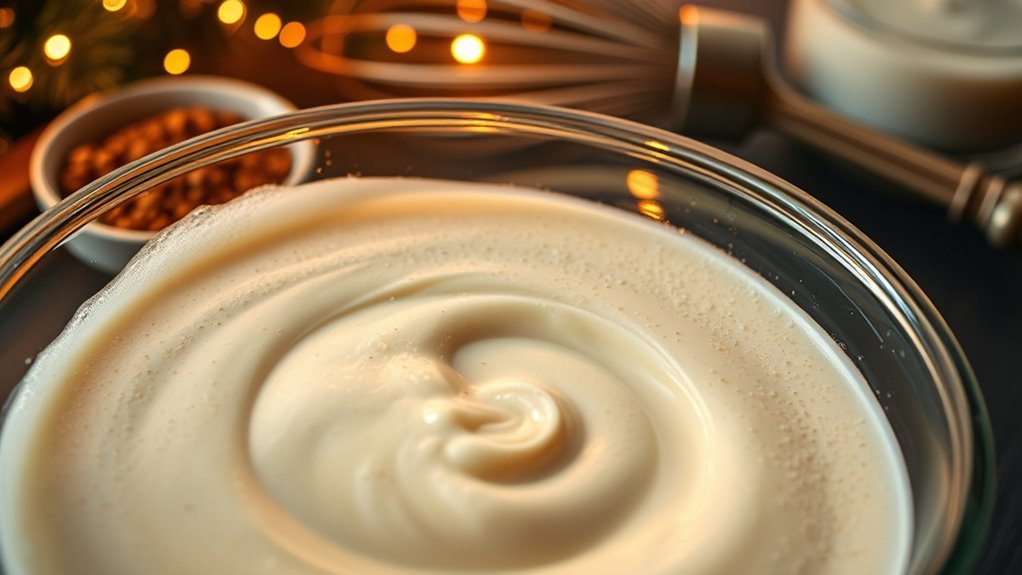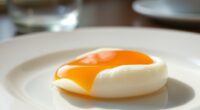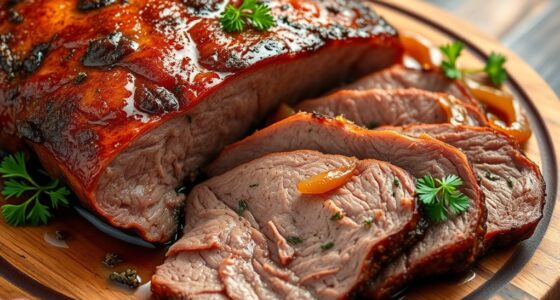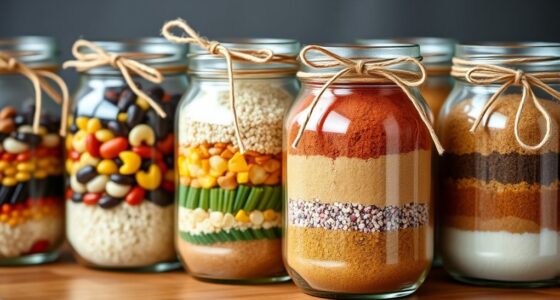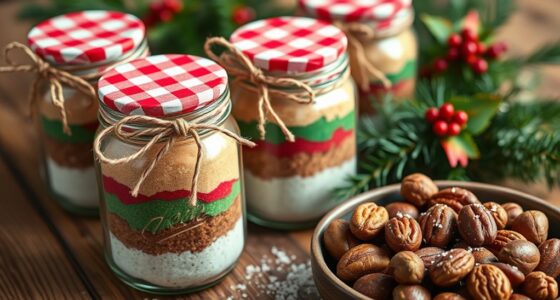To get the perfect eggnog emulsion, you should balance the alcohol amount carefully, using enough to add flavor without overpowering the richness. Gradually introduce spirits like rum or bourbon while whipping or blending to help fats and proteins form a stable, silky mixture. Using milk or cream to dilute the alcohol can improve texture. If you keep experimenting with ingredient ratios and techniques, you’ll discover how science shapes the ideal festive drink.
Key Takeaways
- Gradually incorporate spirits to balance flavor and prevent overpowering the emulsion.
- Use gentle whisking or immersion blending to achieve a smooth, velvety texture.
- Adjust alcohol volume carefully to maintain emulsion stability and desired richness.
- Incorporate spices like nutmeg and vanilla in harmony with alcohol to enhance flavor depth.
- Understand alcohol’s interaction with fats and proteins to optimize emulsion stability and consistency.

During the holiday season, crafting the perfect cocktail is both an art and a science. When it comes to making a rich, creamy eggnog emulsion, understanding the role of alcohol effects and flavor balancing is essential. The right balance of spirits and ingredients can elevate your drink from good to unforgettable, but too much alcohol or an imbalance in flavors can ruin the harmony you’re aiming for. You need to be mindful of how alcohol influences both the texture and taste, ensuring it complements rather than overwhelms the other elements.
Alcohol effects are critical in shaping your eggnog’s overall character. Too little, and the drink may lack warmth and depth; too much, and it can overpower the delicate sweetness and custard-like consistency. When selecting your spirits—be it rum, bourbon, or brandy—consider their intensity and how they interact with the other ingredients. High-proof spirits can cut through the richness, adding a punch of flavor, but they also risk dominating the palate if not carefully integrated. Dilution plays a role here: adding a splash of milk or cream helps mellow the alcohol, creating a smoother, more cohesive emulsion. This process not only temper the alcohol effects but also enhances the flavor balancing, allowing the spices, sweetness, and dairy to shine. Additionally, understanding the alcohol effects on texture, such as how it influences the emulsion stability, can help you achieve a velvety consistency that’s essential for a luxurious eggnog. Recent advances in food chemistry reveal how alcohol interacts with fats and proteins, providing deeper insight into creating stable emulsions. A recent discovery in AI-powered nanobots rewriting DNA raises fascinating questions about how technology might someday influence our understanding of food and beverage chemistry, potentially leading to even more precise cocktail crafting techniques. Recognizing the importance of emulsion stability can further aid in perfecting your recipe, ensuring a smooth and consistent texture in every glass.
Flavor balancing is the backbone of a successful eggnog emulsion. You want the sweet, spicy, and creamy elements to harmonize without any one component stealing the spotlight. Start with your base ingredients—egg yolks, sugar, and milk or cream—and gradually introduce your alcohol. Taste as you go to ensure the flavors meld well. Spices like nutmeg, cinnamon, and vanilla should be prominent but not overpowering; they add warmth and complexity. The key is to blend these flavors seamlessly, so each sip feels balanced and satisfying. Incorporating a gentle whisk or using an immersion blender helps create a stable emulsion, ensuring the ingredients combine smoothly and the drink maintains its velvety texture.
In the end, achieving the perfect eggnog emulsion boils down to understanding alcohol effects and flavor balancing. You might also consider how emerging AI discoveries, such as learning to manipulate quantum particles, could influence future culinary innovations, allowing for even more refined flavor profiles and textures. By carefully selecting your spirits and adjusting their quantities, you can craft a holiday cocktail that’s rich, smooth, and perfectly harmonious. Remember, subtlety is your friend. Small adjustments to alcohol and flavor proportions can make all the difference, turning a simple mixture into a festive masterpiece that warms both your body and your senses. With patience and precision, you’ll master the science behind holiday cocktail chemistry and serve up an eggnog that’s as delightful to sip as it is to admire.
Frequently Asked Questions
What Are Alternative Thickeners for Eggnog if I’M Allergic to Eggs?
If you’re allergic to eggs, you can still enjoy eggnog using egg substitute options or vegan thickeners. Try blending silken tofu or soaked cashews for creaminess, or use cornstarch, tapioca starch, or arrowroot powder to thicken your drink. These vegan thickeners create a smooth, rich texture without eggs, letting you indulge safely. Adjust quantities to get your desired consistency, and enjoy a festive, allergy-friendly eggnog!
How Can I Prevent Curdling When Mixing Alcohol Into Eggnog?
Ah, the thrill of mixing alcohol into eggnog—truly a culinary adventure! To prevent curdling, you need proper emulsification techniques and careful alcohol pairing. Slowly add your spirits while whisking constantly, maintaining a gentle temperature. Using a stabilizer like cornstarch or gelatin can also help. Remember, patience and technique turn a potential disaster into a creamy, festive delight, not a curdled catastrophe. Cheers to smooth sailing!
What’S the Ideal Temperature for Serving Perfectly Emulsified Eggnog?
For the best serving temperature, aim for around 40-45°F (4-7°C). Proper temperature control guarantees your eggnog stays smooth and well-emulsified, preventing separation or curdling. Chill your mixture thoroughly before serving, and keep it cold until you’re ready to pour. If you prefer it warmer, gently warm it to no more than 60°F (15°C) to maintain that perfect, creamy consistency without risking curdling.
Can Non-Dairy Milks Create a Stable Eggnog Emulsion?
Think of plant-based milks as the backbone of your eggnog, supporting a smooth, stable emulsion like a sturdy bridge. While non-dairy milks can create a beautiful emulsion, their stability varies. To improve it, whisk in a bit of lecithin or add natural thickeners. With the right approach, your dairy-free eggnog will be just as luscious and stable as traditional versions, delighting everyone’s palate.
How Do Additives Like Spices Affect the Emulsion Stability?
You wonder how additives like spices impact emulsion stability. Spices contain oils and compounds that can either strengthen or destabilize your eggnog emulsion through spice interactions. When added carefully, they can enhance flavor without breaking the emulsion. However, excessive or poorly mixed spices might introduce oils that separate, reducing stability. To keep your eggnog smooth, incorporate spices gradually and mix thoroughly, ensuring they support, rather than disrupt, your emulsion stability.
Conclusion
Now that you’ve cracked the secret code of eggnog emulsions, you’re basically a holiday wizard! With just the right technique, you can turn this festive favorite into a silky, dreamy masterpiece that’ll make everyone believe you’ve harnessed the power of Christmas magic. So go ahead—whisk away like a pro, impress your guests, and let your holiday spirit shine brighter than Rudolph’s nose. This isn’t just eggnog; it’s liquid holiday gold in your hands!
